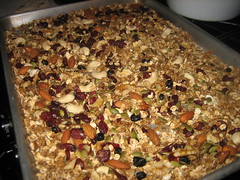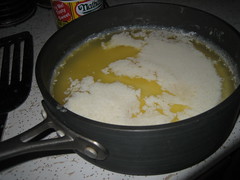Anyway, I'll be starting out with aneasy intro post and recipe. Granola. You may think it's crazy hippy food, or you may find it incredibly delicious. I fall into the latter category. Granola sprinkled on top of yogurt is my go-to breakfast. However, I have a problem with grocery store granola.
1: it's usually loaded with sugar and fat, and in cheaper brands, that fat is often partially hydrogenated and the sugar is high fructose corn syrup, and since I believe that "corn sugar" is in fact inferior to natural sugars, I prefer to avoid it.
2: good quality granola is EXPENSIVE! It can easily run upwards of $10 for a little bag that will last you a week. It certainly doesn't make for an affordable alternative to cereal.
However, the solution to this problem is simple. Make your own granola. It's easier than you may have ever dreamed, and so much cheaper.
I will give credit to Alton Brown for his granola recipe. I use this as the starting point for all of my batches of granola; however, I alter it substantially every time, and pretty much only stick with the measurements of oats and salt - everything else is up for negotiation.
Personally, I try to avoid vegetable oil for a number of reasons, primarily health and flavor. So I substitute butter or coconut oil, generally, for the fat, and I tend to use a bit less - there's no requirement that you have to use that much oil or sugar. So, melt a couple tablespoons of your favorite fat in a saucepan, and then add your sweetener. Now, you can go almost anywhere with sweeteners as well. The more granulated sugar you use, the better your granola will clump together, but if that's not important to you, simply add a tablespoon or two, or forgo it altogether. Flavor will be the determining factor of your other choices of sweetener. I have used evaporated cane sugar, palm sugar, honey, molasses, agave nectar, and maple syrup with good results. Next, add your spices: cinnamon is almostalways a must for me, and a little goes a long way, but I'm also fond of ginger, allspice, nutmeg, and cardamom. Add those in the saucepan and cook until the sugar starts to melt a bit, and you're set!
Of course, you also need to choose what sort of nuts or seeds you'd prefer to see in your granola. Almonds, slivered or whole, hazelnuts, macadamias, walnuts, peanuts, and pecans are all excellent choices; sunflower, pumpkin, sesame, or poppy seeds add unique character; and coconut is a good assertive option. Thechoices you make will have a significant effect on the flavor, as will the decision to add them to the oats before or after cooking - if you purchase pre-roasted nuts or prefer them raw, save it until your granola is out.
Choice of dried fruit is also important, and pretty much limited to whatever you can find - personally, my favorites are cranberries, cherries, blueberries, and dried apricots, but there are plenty of other things to choose from.
So, once you've created your sugar/fat/spice mixture, pour it over your measured granola and nuts and turn until it is well mixed. Spread on a sheet pan, place in a 275 F oven, and stir ever 15 mintues for a total of 1 hour and 15 minutes. Make sure that you have a relatively thin and even layer on your pan or it won't toast evenly. Once you remove it from the oven and cool it a bit, stir in your raw/pre-roasted nuts and fruits, place it in a plastic bag, and you're good to go!
This is my current batch of granola:

Allspice, cinnamon, ginger, butter, sugar, and maple syrup are the seasonings, and I purchased a "heart healthy" mix of pumpkin seeds, walnuts, almonds, cashews, raisins, and cranberries from Fresh Market. You are only limited to what you can do by your own imagination! Enjoy.
 On my last
On my last 





